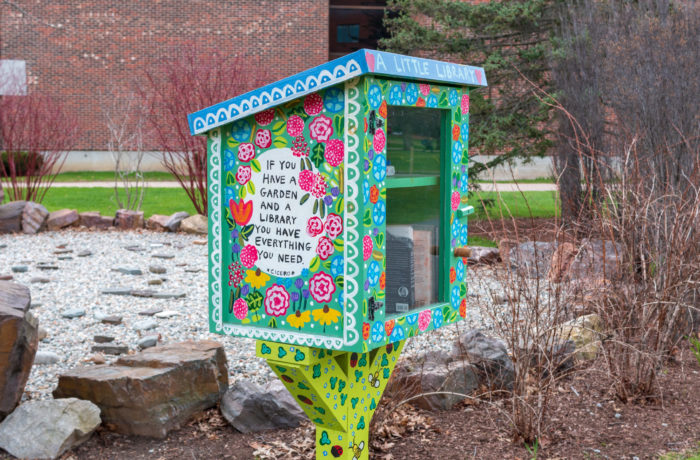
By Anna Meusel
“Show me how you run zig-zag and go hide in the woods!” Principal Kate Torrey pitches her voice to sound high and encouraging, but the request of her Morristown Elementary students belies its serious value. At this K-4 grade school in sleepy Morrisville, Vt., the playground has turned into training grounds for active shooter drills.
On a damp April afternoon, the green double-doors to the front of the squat, 60’s-brick building stand clicked closed, anticipating a flood of children pushing them open from the inside to come out for recess—or to practice out-running bullets. Where brown fields stand promisingly, recovering from the harsh winter, the tumbling stampede of children’s feet will cross the swath of playing space to become the site of a new safety drill implemented under Morristown’s ALICE training program.
In 2014, 88 percent of public schools surveyed by the National Center for Education Statistics had a written plan for the event of a shooting, but only 70 percent drilled their school members on it, according to the 2016 School Survey on Crime and Safety. With the increasing national coverage of school shootings in the wake of Sandy Hook to Stoneham Douglas, safety concerns have increased, and more educators will change those statistics by implementing more active shooter training.
What can schools do? As an alternative to traditional school lockdown procedures, Morrisville will implement ALICE training, which stands for “Alert Lockdown Inform Counter Evacuate.”
“Enough public mass shootings have happened to figure out how to save more lives than just huddling in a corner,” Torrey says, describing previous protocols. “It’s not about staying silent and staying in the corner. No. It’s about getting as much help as you can.”
Morrisville’s police department came into Morristown Elementary this spring under Superintendent Tracy Wrend’s approval to spend after-school hours actively training the teaching staff on the ALICE approach. In coarse-carpeted classrooms, surrounded by bright bulletin boards showcasing hand-drawn art projects with the colorful scribbles of five- to ten-year olds, teachers practice barricading classroom doors and windows, throwing materials to distract intruders, charging an armed person, and techniques to grab and bring one down to the ground, Torrey says. She described the experience as empowering.
“They really taught us some self-defense skills, [like] how to disarm a gunman. You see these little first grade teachers taking down a cop,” Torrey says, her tone breaking into chuckling humor for the first time during the grim conversation. “It was awesome. It was great.”
But not all teachers felt as enthusiastic about the physicality of the training. Tammy Gresham, one of Morristown’s kindergarten teachers, says practicing the counter techniques was out of her comfort zone.
“This is one of my greatest fears. However, this opportunity provided me with firsthand experience without the real threat,” she says.
How should children be prepared? The school shooting conversation cannot take place without considering how to involve the children whose safety remains the main concern in this nation-wide movement—and not everyone agrees on the best approach to ensure preparation while avoiding introducing unnecessary fear and trauma into the classroom.
Balancing knowledge, training, and a sense of safety for young students remains “a hot button issue,” says Dr. Eric Rossen, a nationally certified school psychologist and the National Association of School Psychologists’ Director of Professional Development and Standards.
“Safety drills are very important. They can help prevent harm, even save lives. The question is how they are done and in what context,” Rossen says. “It’s one thing to do an occasional lockdown drill explaining to students that it’s to make sure we’re all safe just in case something happens outside. It’s another to tell students that someone can come into the school with a gun at any moment, and they need to be prepared to hide.”
Torrey acknowledges that her staff now grapples with that same problem. “We have to be careful about not traumatizing them with the stuff that we learned how to do,” she said.
As superintendent, Wrend acknowledges that training across the schools in the Lamoille South Supervisory Union has the potential for many different reactions. She calls ALICE training a “another tool in the tool box for safety” that allows the entire school community to work on the sensitive subject. The difference between informing and traumatizing
Language choice, above all, can make the difference between informing and traumatizing. At Morristown, teachers are advised to avoid talking about weapons, instead speaking in generalities about “what if there’s a bad guy” or “what if someone doesn’t belong here.”
In terms of active training, Morristown students will be taught that they do not have to stay put or huddle, Torrey says. They plan to practice hiding in different cubby-holes, evacuating, and running to safer spots from all corners of the building.
And that is when the conversation gets particularly grim. “If you can teach them to run zigzag, then, if bullets are being shot at them, they are a more difficult target to hit,” Torrey says, painting the horrific scene of a worst-case-scenario that schools are finding themselves forced to consider. The playground becomes the potential setting for a war-like situation rather than a carefree safe-haven.
Although this prospect feels scary, says Morristown kindergarten teacher Diane Nicholls, “I’ve always said I would do it anyway if I felt my students were in harm’s way and had a chance for survival if we ran.”
In order to execute this daunting drill, the staff has been briefed on how to communicate as clearly and calmly as possible.
“Play a game and run zig-zaggy to the woods!” Torrey says with the same high-pitched tone, practicing how to speak to her students; then, shifting back to the blunt reality of the tactic: “Treat it like a game.”
Even this light-hearted approach proves difficult to stomach, but the alternative is talking to children about out-running bullets.
“I can’t bring myself to say that to a five-year-old,” Torrey says. “You start talking about things like that, and teachers start crying.”
Rossen believes that the discussions around drilling are too heavily weighted toward worst-case-scenario when they could be better targeted towards proactive measures that enhance the general sense of safety within schools.
“Overly burdensome physical safety measures tend to make students feel less safe, and come at an extreme cost for an occurrence that is less likely to occur than someone being struck by lightning multiple times. Schools still remain among the safest places for students.”
Rossen advises that schools should focus on tackling prevention and the mental health side of the topic, “Focusing on ways to improve the overall school culture and climate.”
But Torrey argues that physical drillings remains critical for safety in the grim reality of school shooting statistics.
Torrey explains plans to hold information sessions about ALICE training for parents prior to drilling the kids. Making sure caregivers stay briefed on the changes and protocol ensures that the proper discussions can be had to reassure curious students—and parents alike—to help all parties feel safe.
After the conversation, it is hard to look at the Morristown playground the same way. Each field that should hold games of kickball simply risks playing in a vast expanse of exposure. The soccer nets stand useless, their poles too thin to provide a hiding spot for even one child. The wood-lined perimeter seems hopelessly distant, posing a run too far to guarantee safety. Each tree fills the role of protective coverage, but even still some stand too close to the building to be considered truly safe if bullets fly.
Imagining an active shooter, as educators everywhere now must, it is hard to look at any school the same way.
“It’s intense, and it’s heavy,” Torrey admits, “but better to be prepared and trained.”
For tips on talking to children about violence, school safety, and active shooter training, visit the National Association of School Psychologists’ website at www.nasponline.org.
Anna Meusel ’19 wrote this piece last spring for a St. Michael’s class. The Burlington Free Press published the article in July.


